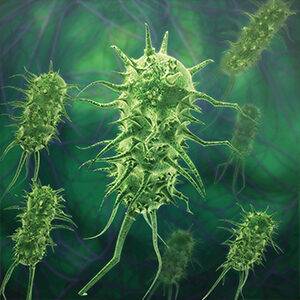What is scabies?
Scabies is an infestation of the skin with microscopic mites, Sarcoptes scabiei. Most often people who are infected have fewer than 10-15 mites.
Please note that Spokane Regional Health District does not identify or test insects, and does not have a pest control program. The materials provided on this web page are designed to answer basic questions about scabies.
What is crusted or Norwegian scabies?
Some immunocompromised, elderly, disabled, or debilitated people are at risk for a severe form of scabies called crusted (Norwegian) scabies. People with crusted scabies have thick crusts of skin that contain large numbers of scabies mites and eggs. The mites in crusted scabies are not more harmful, but are much more numerous (up to 2 million per patient). Because they are infested with such large numbers of mites, people with crusted scabies are very contagious to other people. In addition to spreading scabies through brief skin-to-skin contact, people with crusted scabies can transmit them indirectly by shedding mites and contaminating items such as clothing, bedding, and furniture. Persons with crusted scabies should receive quick and aggressive treatment.
Who gets scabies?
Infestation is common, found worldwide, and affects people of all ethnic backgrounds and social classes. Because scabies spreads easily under crowded conditions where close body and skin contact is common, institutions such as nursing homes, extended-care facilities, childcare facilities, and prisons are often sites of scabies outbreaks. In addition, household members and sexual partners of infested people are also at high risk.
How is scabies spread?
Scabies spread rapidly under conditions where there is prolonged skin-to-skin contact between people; a quick handshake or hug usually will not spread scabies unless the infected person has crusted scabies. An infested person can spread scabies even if he or she has no symptoms. Household pets and other animals do not spread the human form of scabies.
What are the symptoms of scabies?
- Itching. Itching is caused by an allergic reaction to the proteins and feces of the mite. Severe itching, especially at night, is the earliest and most common symptom of scabies.
- Rash. A pimple-like itchy rash is common and may affect much of the body or be limited to common sites such as between the fingers, wrist, elbow, armpit, penis, nipple, waist, buttocks, and belt-line. The head, face, neck, palms, and soles are often infested in infants and very young children, but usually not in adults and older children.
- Burrows. Tiny burrows are sometimes seen on the skin. These are caused by the female scabies mite tunneling just beneath the surface of the skin. Burrows appear as tiny raised and crooked grayish-white or skin-colored lines on the skin surface. Because mites are often few in numbers, these burrows may be difficult to find.
People with crusted scabies may not show the usual signs and symptoms of scabies such as the characteristic rash or itching.
How soon after an exposure to scabies do the symptoms appear?
The first time a person gets scabies they usually have no symptoms during the first four to six weeks. In a person who has had scabies before, symptoms usually appear much sooner, one to four days after exposure.
How is scabies diagnosed?
To diagnose scabies, your doctor examines your skin, looking for signs of mites, including the characteristic burrows. When your doctor locates a mite burrow, he or she may take a scraping from that area of your skin to examine under a microscope. The microscopic examination can determine the presence of mites or their eggs. However, a person can still be infested even if mites, eggs, or fecal matter cannot be found as fewer than 10-15 mites may be present on an infested person who is otherwise healthy.
How is scabies treated?
Treatment is recommended for the infested person as well as all household members and sexual contacts, particularly those who have had prolonged direct skin-to-skin contact with the infested person within the preceding month. All people should be treated at the same time to prevent reinfestation.
Products used to treat scabies are called scabicides and are available only with a doctor’s prescription. The instructions contained in the box or printed on the label should always be followed carefully. Always contact a doctor or pharmacist if unsure how to use a particular medicine.
When treating adults and older children, scabicide lotion or cream should be applied to all areas of the body from the neck down to the feet and toes. When treating infants and young children, scabicide lotion or cream should also be applied to their entire head and neck. The lotion or cream should be applied to a clean body and left on for the recommended time before washing it off. Clean clothing should be worn after treatment.
No “over-the-counter” (non-prescription) products have been tested and approved to treat scabies. Never use a scabicide intended for veterinary or agricultural use to treat humans!
Itching may continue for several weeks after treatment even if all the mites and eggs are killed. If itching is still present more than two to four weeks after treatment or if new burrows or pimple-like rash lesions continue to appear, retreatment may be necessary.
Skin sores that become infected should be treated with an appropriate antibiotic prescribed by a doctor.
What can be done to prevent the spread of scabies?
An adult female mite can live up to a month on a person but will not survive for more than 48-72 hours away from the body. Fumigation of living areas is unnecessary. To prevent re-infestation and to prevent the mites from spreading to other people, take these steps:
- Clean all clothes and linen. Use hot, soapy water to wash all clothing, towels and bedding used at least two days before treatment. Dry with high heat. Dryclean items you can't wash at home.
- Starve the mites. Consider placing items you can't wash in a sealed plastic bag and leaving it in an outof-the-way place, such as in your garage, for a couple of weeks. Mites die if they don't eat for a week.

Communicable Disease Investigation & Prevention (CDIP)
Epidemiologists monitor, track, and respond to infectious disease in the community to prevent spread of illness.

